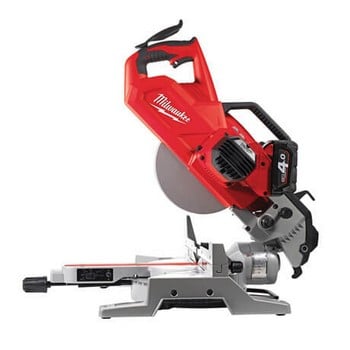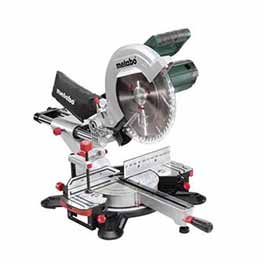Mitre Saws
Useful Blog Posts & Guides
Find out more about Mitre Saws
Mitre saws are essential tools for woodworking and construction projects, designed to make precise crosscuts and mitre cuts at various angles. These saws feature a circular blade mounted on a swing arm, allowing the blade to pivot left or right to create angled cuts. This versatility makes them ideal for tasks such as framing, crown moulding, and other trim work.
One of the key advantages of a mitre saw is its ability to produce clean, accurate cuts quickly. Many models come equipped with laser guides or LED lights to enhance visibility and ensure precision, making it easier to follow cut lines. Additionally, there are different types of mitre saws available, including compound and sliding models. Compound mitre saws can tilt in one or both directions, allowing for bevel cuts, while sliding ones have a sliding feature that extends the cutting capacity for wider boards.
Mitre saws are user-friendly, making them suitable for both beginners and experienced woodworkers. They typically include safety features such as blade guards and electric brakes to stop the blade quickly after use. Overall, they are invaluable tools that enhance the efficiency and accuracy of cutting tasks in various woodworking applications.
Sliding Compound Mitre Saws
A sliding compound mitre saw is a versatile tool designed for precision cutting at various angles and depths. Unlike standard ones, the sliding feature allows the saw blade to move forward and backward, significantly increasing the cutting capacity. This makes it ideal for wider boards and larger materials.
One of the standout features of sliding compound mitre saws is their ability to make both mitre and bevel cuts. A mitre cut is an angled cut across the width of the material, while a bevel cut is an angled cut along the thickness. This dual capability makes it perfect for projects like crown moulding, picture frames, and other detailed woodworking tasks.
Additionally, many models come with laser guides or LED lights to help improve accuracy and visibility during cuts. The adjustable fence and built-in clamps ensure that the material stays secure, allowing for safer and more precise cutting. Overall, sliding compound mitre saws are an excellent choice for both professional carpenters and DIY enthusiasts looking to tackle complex cutting tasks with ease and precision.
Crosscut Mitre Saws
Crosscut, often referred to simply as mitre saws, are specialised tools designed for making precise crosscuts at various angles. These saws are essential for tasks that require accurate cuts across the grain of the material, making them ideal for framing, trimming, and moulding projects.
The primary function of a crosscut mitre saw is to cut wood and other materials at specific angles, typically 0 to 45 degrees, allowing for clean and professional-looking joints. The saw features a rotating arm that holds the blade, which can be adjusted to achieve the desired angle. This makes it particularly useful for creating mitred edges, which are often used in picture frames, door frames, and crown moulding.
Crosscut mitre saws come in various sizes, with blade diameters usually ranging from 8 to 12 inches. The larger the blade, the deeper and wider the cut capacity. Some models also include features like laser guides for enhanced accuracy, dust collection systems to keep the workspace clean, and ergonomic handles for comfortable operation.
While crosscut mitre saws are primarily designed for wood, they can also be equipped with specialised blades to cut through other materials, such as plastic or aluminium. However, they are not suitable for cutting metal without the appropriate blade. Overall, a crosscut ones are an invaluable tool for anyone looking to achieve precise, angled cuts in their woodworking projects.
Mitre Saws FAQs
What is a mitre saw used for?
A mitre saw is primarily used for making precise crosscuts and angled cuts in wood. It's essential for tasks like framing, moulding, and trim work, allowing you to achieve clean and accurate cuts quickly. Whether you're working on a DIY project or a professional job, it is a valuable tool for achieving the right angles and finishes.
What is the difference between a compound and a sliding mitre saw?
The main difference between a compound and a sliding mitre saw is their cutting capabilities. A compound mitre saw can tilt to make bevel cuts in addition to making mitre cuts, while a sliding mitre saw features a sliding arm that allows it to cut wider boards by extending the blade's reach. This makes sliding more versatile for larger projects, whereas compound mitre saws are great for angled cuts and bevels on smaller pieces.
How do I choose the right blade for my mitre saw?
Choosing the right blade for your mitre saw depends on the material you’re cutting. For wood, a carbide-tipped blade is commonly used, as it provides clean cuts and durability. If you're cutting softer materials like plywood, a fine-toothed blade can help reduce splintering. For cutting metal or plastic, make sure to select a blade specifically designed for those materials. Always consider the tooth count and type based on the finish you want and the material thickness!
Can I make bevel cuts with a standard mitre saw?
No, a standard saw typically does not make bevel cuts. To make bevel cuts, you would need a compound mitre saw, which can tilt to create those angled cuts.
What safety features should I look for in a mitre saw?
When looking for safety features in a mitre saw, consider the following:
Blade Guard: Ensures the blade is covered when not in use.
Electric Brake: Stops the blade quickly when the trigger is released.
Lock-Off Switch: Prevents accidental start-up.
Stable Base: Provides a sturdy platform to reduce movement during cutting.
Dust Collection: Helps keep the workspace clear and reduces inhalation of dust.
These features can help enhance safety while using the saw!
How do I maintain my mitre saw?
To maintain your mitre saw, follow these steps:
Clean the Saw: Regularly remove dust and debris from the saw, especially around the blade and motor.
Check the Blade: Inspect the blade for dullness or damage. Replace or sharpen it as needed.
Lubricate Moving Parts: Apply lubricant to the pivot points and other moving parts to ensure smooth operation.
Tighten Loose Screws: Periodically check and tighten any loose screws or bolts.
Store Properly: Keep the saw covered or in a dry place to protect it from moisture and dust when not in use.
Regular maintenance will help extend the life of your mitre saw and keep it performing well!
Can I use a mitre saw for cutting metal?
Yes, you can use a mitre saw for cutting metal, but you need to ensure that you have the right blade designed specifically for metal cutting. A carbide-tipped blade or a blade with high tooth count is ideal for this purpose. Just make sure to follow safety precautions, as cutting metal can create sparks and debris.
What is the maximum cutting capacity of a mitre saw?
The maximum cutting capacity varies depending on the model and size. Typically, a standard 10-inch mitre saw can cut up to 6 inches in height and 12 inches in width, while a 12-inch saw can handle larger cuts, often up to 8 inches in height and 14 inches in width. Always check the manufacturer's specifications for the exact cutting capacity of your specific saw!





Shop our wide range of Mitre Saws at Trading Depot. Achieve clean, precise cuts with our range of high-performance saws, perfect for both DIY enthusiasts and professionals. Designed for cutting wood, plastic, and even metal with ease, mitre saws offer the flexibility of angled and bevel cuts, ideal for framing, moulding, and other intricate work. Featuring laser guides, adjustable angles, and powerful motors, these saws ensure accuracy and efficiency on every project. From compact models for small workshops to robust, industrial-grade tools, find the right mitre saw for your needs.